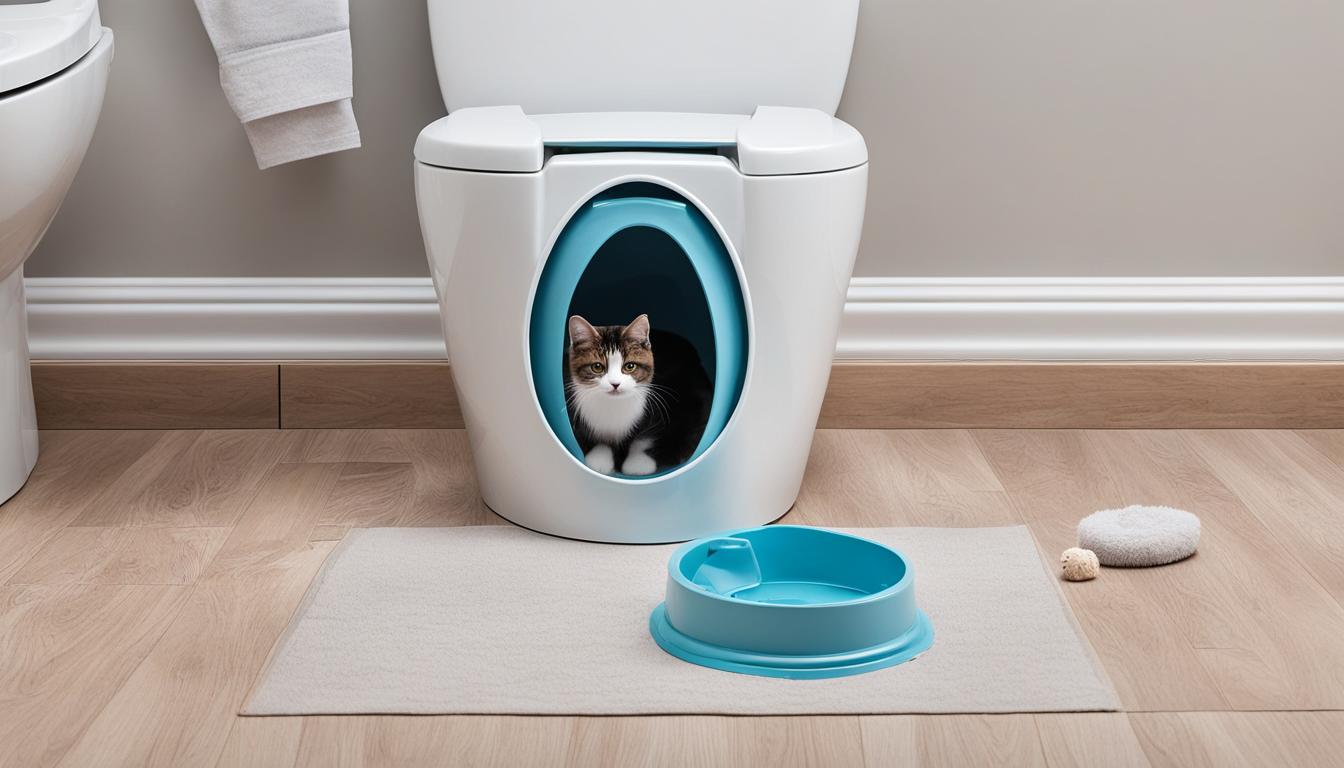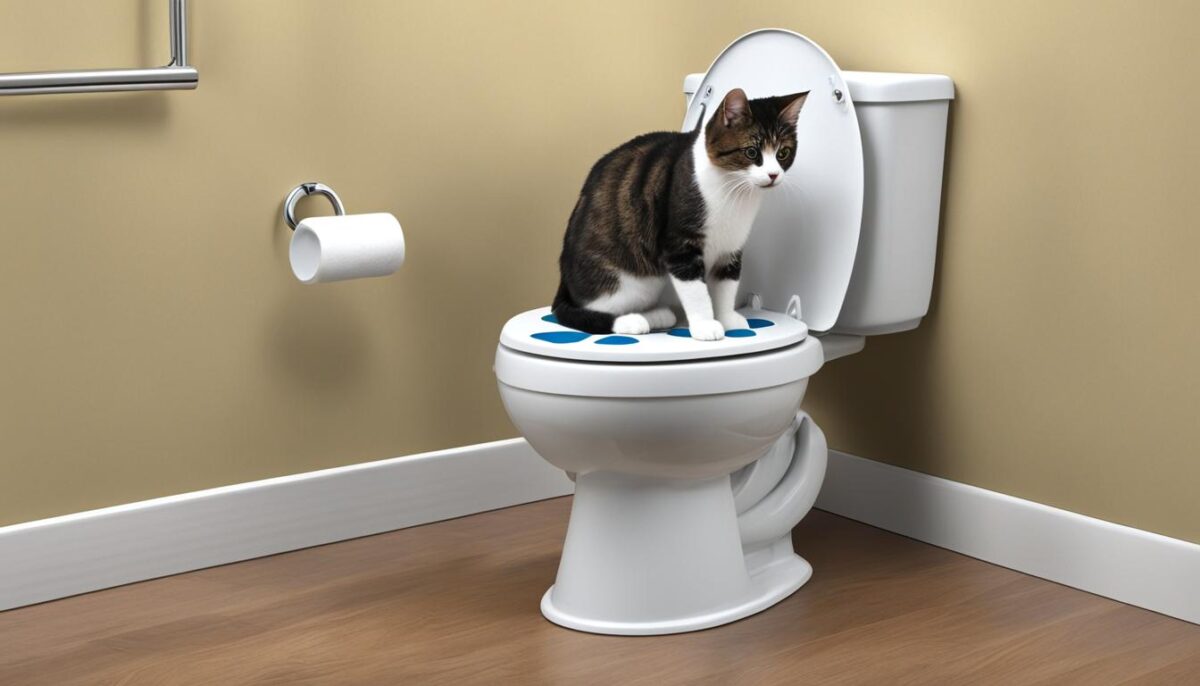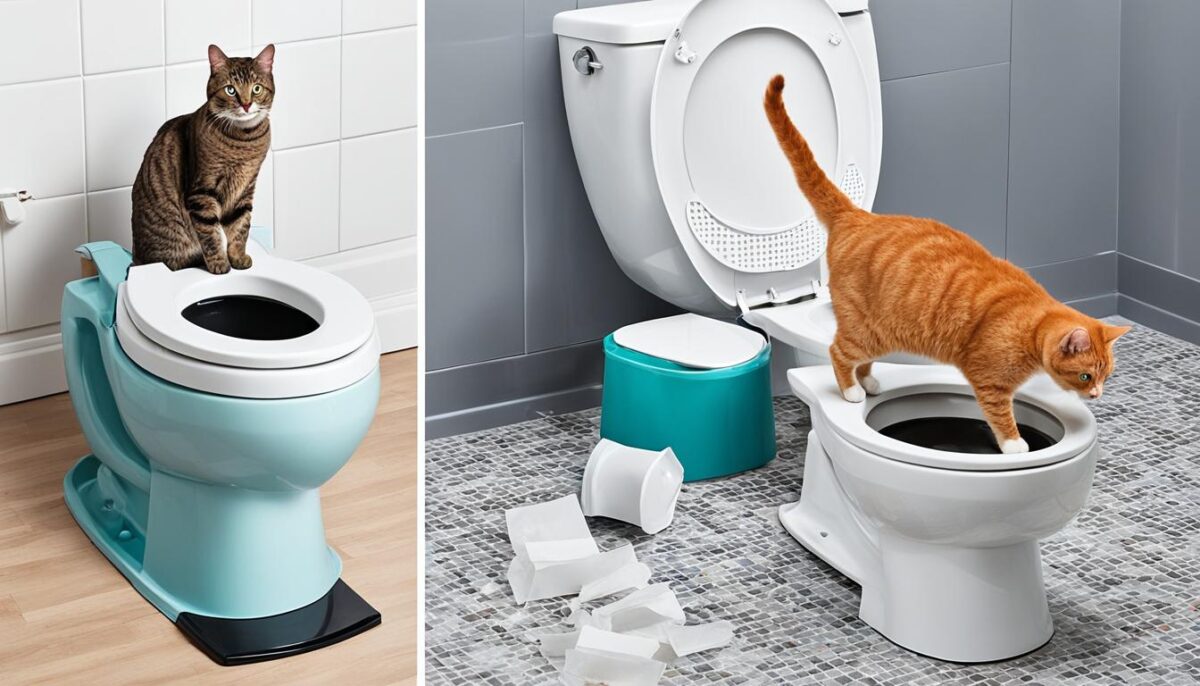Are you ready to say goodbye to litter boxes? You can teach your cat to use the toilet! This is called toilet training cats. It’s a clean way for your pet cat to go potty. No more litter box means less mess in your home. Cat potty training can help make your house smell better, too. Let’s learn how to help your cat be neat and tidy with their bathroom habits.
Some cats can learn to use a toilet instead of a litter box. It’s like when people use the potty. If your cat learns this, you won’t have to clean a litter box. That’s a big help! But, not all cats can do this, and that’s okay. We need to make sure it’s good for your cat and won’t make them upset. We want happy cats!
Before we begin, let’s talk to a vet who knows a lot about cats. They will tell us if this is a good idea for your furry friend. Ready to start a clean and tidy journey with your cat? Let’s go!
Key Takeaways
- Teach your cat to use the toilet and skip the litter box.
- Make sure toilet training is good for your cat.
- Keep your house smelling nice without litter boxes.
- Always talk to a vet before starting something new with your cat.
- Keep your cat happy and stress-free while they learn.
Is Toilet Training Right for Your Cat?
Hi, cat friends! Have you ever thought about teaching your kitty to use the toilet? It could mean no more litter boxes! But, is it right for your furry pal? Let’s find out together.
The Benefits of a Litter-Free Home
Imagine a home without a litter box—sounds good, right? Your home will be cleaner, and there’s no more scooping or buying litter. This is what happens when you teach your cat to use the toilet. It’s called toilet training, and it can be pretty cool!
Understanding Your Cat’s Bathroom Behavior
Cats have their own way of doing things, especially when it comes to their bathroom habits. They like to dig and cover their business. Toilet training is different from what they’re used to, but some cats might like learning new things!
Signs That Your Cat May Be Ready
Your cat might be ready for toilet training if they are already good at using their feline litter box and like to try new things. Cats that follow you to the bathroom or look curious about the toilet could be giving you a hint that they’re ready to learn. Here’s a neat table to help you see other signs:
| Signs Your Cat Might Be Ready for Toilet Training |
|---|
| Your cat follows you to the bathroom |
| They watch the toilet with interest |
| They’re good at using their litter box |
| They like new games and challenges |
| They don’t make a lot of mess with their current litter box |
Toilet training your cat can be great, but you need to be patient. It takes time for kitties to learn new things, just like for you. And remember, every cat is different, so what works for one cat might not work for another. You both will do great if you take it step by step and have lots of fun together!
Cats Using Toilet: Step-by-Step Training Guide
Training your cat to use the toilet can be a big help in keeping your home clean. Here’s a feline training guide that shows cat potty training steps you can follow. With patience, you can help improve your kitty toilet training skills and develop good cat bathroom habits. Let’s start!
Step 1: Move the litter box near the toilet. This gets your cat used to being around the toilet.
Step 2: Raise the litter box a little at a time. This helps your kitty feel okay being up high, like on a toilet.
Step 3: Put the litter box on the toilet seat. Now your cat is closer to actually using the toilet!
Step 4: Swap the litter box for a special bowl or training seat. The Litter Kwitter is a good one to try. It has different trays that let your cat learn at their speed.
Step 5: Slowly fill the bowl with water instead of litter. This teaches your cat to balance on the toilet rim.
And remember, always keep the toilet seat up for your cat and make sure to flush often!
Isn’t it fascinating how you can guide your kitty to use the toilet? With these simple steps, you’ll have a cleaner home and a proud pet companion. Give it a try and see!
Overcoming Common Toilet Training Challenges
When you start toilet training your kitty, you might see some toilet training setbacks. Don’t worry, this happens! Cats can get cat anxiety with new things. But with love and a bit of know-how, you can help your furry friend get past these bumps in the road.
Troubleshooting Accidents and Setbacks
If your cat has a slip-up, keep calm and help them try again. It’s like learning to ride a bike – sometimes you wobble and need another go!
Adjusting Training Techniques for Anxious Cats
If your cat feels nervous, it’s okay to slow down. Give them time to get used to each step. You know your pet best, so tweak the training to make sure they feel safe and happy.
Ensuring Safety Throughout Training
Keeping your cat safe is super important. Make sure everything fits just right and watch how they do. If things seem tricky, it could mean toilet training isn’t the best pick for your pal.
Here’s a table that might help when you’re training your cat:
| Problem | What You Can Do | Things to Watch For |
|---|---|---|
| Skittish Cat | Go slow and give extra cuddles. | Shy or hiding more than usual. |
| Missed the Toilet | Clean up, stay positive, and encourage your cat. | Doing it often or not wanting to try. |
| Doesn’t Like Change | Introduce new steps little by little. | Whining or being grumpy. |
The Environmental and Health Considerations
When you think about toilet training your cat, you should know about the stuff that can affect our planet and your cat’s health. The litter that goes away when you flush can mix with water that people might use later. This is because it can have tiny bugs called Toxoplasma gondii in it. These bugs can make some people very sick, like moms-to-be or people who can get sick easily. Plus, if your cat goes potty in the toilet, it’s harder to check if they are healthy. Just like you, cats can get sick, and noticing changes in their potty can help find these problems early. So, it’s good to think about keeping the earth safe and taking care of your cat when deciding if toilet training is right.
Toxoplasma Gondii and Water Supply Concerns
You’ve probably never heard of Toxoplasma gondii, but it’s a big deal. These little bugs can get into the water and make some people sick. That’s because the places that clean our water can’t always catch them. This is serious for the environment and for people, so it’s something to really think about.
Monitoring Your Cat’s Health After Transition
When your cat starts to go potty in the toilet, it can be hard to know if they are feeling okay. If your cat keeps their potty too long or if things change, it might mean they’re not well. Keeping an eye on these signs is part of taking good care of your furry friend. It’s all about making sure your cat stays happy and healthy.
Considering the Long-Term Impacts
Litter boxes can be messy, but teaching your cat to use the toilet has more things to think about than just being clean. You should think about how it can affect the world around you and how it might change the way you look after your cat’s health. Sometimes, caring for pets like cats means finding ways that are best for them and our planet too, which we all call sustainable pet care. Thinking ahead is a nice way to make sure you’re doing the best for your kitty and the earth.
FAQ
What are the benefits of toilet training my cat?
Toilet training your cat can provide a litter-free home, reduce odors, and offer a cleaner living environment for you and your furry friend. It eliminates the need for constant scooping and purchasing cat litter, as well as deep cleaning litter boxes. However, it requires time, patience, and a cat that is open to learning new behaviors.
How can I tell if my cat is a good candidate for toilet training?
Your cat might be ready for toilet training if they are already comfortable with using their litter box and don’t show excessive stress in their current bathroom habits. Curiosity about the toilet or following you into the bathroom could be signs that they’re ready to learn. It’s best to consider your cat’s personality and consultation with a vet or animal behaviorist before you begin.
What is the step-by-step process to train my cat to use the toilet?
Start by gradually moving your cat’s litter box closer to the toilet to get them accustomed to the area. Then, step-by-step, raise the height of the litter box until it is at the same level as the toilet seat. Introduce a training seat like the Litter Kwitter, which helps transition them from litter to balancing on the seat. Eventually, decrease litter in the training seat and introduce water to simulate the toilet environment. Remember to be patient and go at your cat’s pace!
How do I deal with accidents or setbacks during toilet training?
It’s essential to remain patient and consistent. Accidents are a normal part of the learning process. If your cat seems anxious or is struggling, slow down the training process and backtrack a few steps if necessary to reinforce previous learning stages. Always make sure that the training setup is safe to prevent any mishaps or injuries.
Are there environmental and health considerations with cat toilet training?
Yes, flushing cat waste can contribute to environmental issues like the spread of the Toxoplasma gondii parasite, which can be harmful to pregnant individuals and those with weakened immune systems. Moreover, toilet training can make it more difficult to monitor your cat’s health through their waste, potentially missing early signs of health problems. These factors should be weighed when deciding whether toilet training is right for your cat.
Can my cat’s natural behavior affect their ability to learn toilet training?
Absolutely. Cats are creatures of habit, and their instinct to dig and cover their waste might make it challenging to adapt to toilet training. Some cats might not take well to the idea of using a toilet, while others may be more open to it. Understanding your cat’s behavior will help determine the success of the training.
What safety precautions should I take when toilet training my cat?
Ensure that all training equipment fits firmly and securely on the toilet to prevent any accidents. During training, keep the toilet seat down and the lid up to accommodate your cat’s access. Watch your cat closely for signs of distress or reluctance, and always consider their physical abilities—small, elderly, or less agile cats may face more risks.
How will I know if toilet training is causing stress for my cat?
Signs of stress may include your cat avoiding the toilet, showing a decreased appetite, acting out, or exhibiting changes in elimination patterns. If these signs are persistent, it may be best to revert to the traditional litter box and consult your veterinarian for advice.
Could toilet training my cat lead to health issues going unnoticed?
It’s possible since you won’t be able to inspect their waste as readily. Regular health check-ups and monitoring your cat’s behavior for signs of discomfort or changes in toilet habits are essential in catching any health issues early.
What should I do if my cat refuses to use the toilet after training?
If, after a considerable effort, your cat still refuses to use the toilet, it may not be the right method for them. It’s essential to provide a stress-free environment, so switching back to a traditional litter box might be the best solution for their comfort and well-being.


